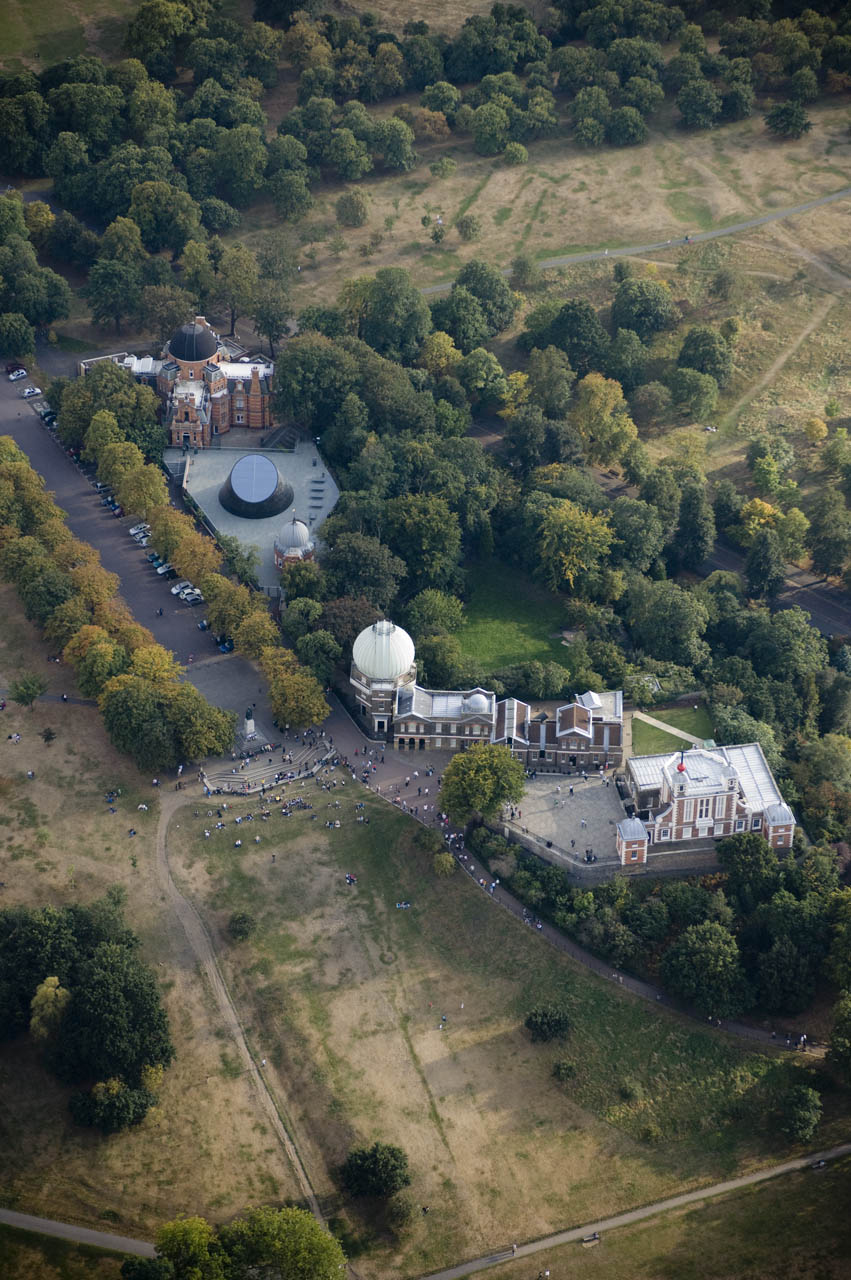
Category of Astronomical Heritage: tangible immovable
Royal Observatory, Greenwich, United Kingdom

Presentation
Geographical position
London Borough of Greenwich, England, United Kingdom.
Location
Latitude 51° 28′ 38″ N, longitude 0° 0′ 0″. Elevation 46m above mean sea level.
General description
The Royal Observatory, Greenwich (ROG) was built in 1675-76 and was a working observatory until the 1950s. The site was handed over to the National Maritime Museum (NMM) piecemeal and opened to the public. It now contains displays on the history of the ROG, finding longitude at sea and time-determination, modern astronomy galleries and a planetarium. Objects include 18th- and 19th-century instruments used at the ROG, such as the Airy Transit Circle, which defines the Prime Meridian of the world.
The Observatory forms part of the property Maritime Greenwich already inscribed on the World Heritage List in 1997 under criteria (i), (ii), (iv) and (vi).
Brief inventory
Buildings:
- Flamsteed House (1675, extended 18th-20th centuries); Meridian Building (1740, extended 19th century); Great Equatorial Building (1857); Altazimuth Pavilion (1899); South Building (1891-99).
Fixed instruments:
- Mural: Halley’s Quadrant (1725), Bradley’s Quadrant (1750), 6ft Mural Circle (1810).
- Transit: Halley’s 5ft (1721), Bradley’s 8ft (1750), Troughton 10ft (1816), Airy Transit Circle (1850).
- Zenith: Bradley’s 12.5ft (1727), Pond’s 9.5ft (1812).
- Equatorial: 28in refractor (1893), Newbegin refractor (c. 1888), Dallmeyer photoheliograph (c.1873).
Moveable instruments:
- Regulators: Tompion (1675), Graham (c. 1750), Earnshaw (c. 1790), Hardy (c. 1825), Shepherd (1852).
- Other items from the NMM collection, a proportion relating to the work of the ROG and its successor, the Royal Greenwich Observatory (RGO).



and the Great Equatorial Building, 2009. Photographs © National Maritime Museum


History
The ROG was founded by Charles II in 1675 to produce astronomical data that would aid navigation. Successive Astronomers Royal contributed to this project with a programme of meridian observation, leading to a successful solution with the publication of the Nautical Almanac from 1767. Work expanded in the 19th century to include magnetic and meteorological observation, photography, spectroscopy and time-signals. In the 20th century work was moved away from Greenwich: magnetic work moved initially to Abinger, Surrey, and the whole institution to Herstmonceux, Sussex, after World War II. The institution moved to Cambridge in 1990 and was closed in 1998.
Cultural and symbolic dimension
The ROG site is of fundamental importance to the history of astronomy, its work and reputation for accuracy being influential throughout the world. It is one of the earliest government-funded scientific institutions and survived for more than three centuries. The choice of the Greenwich meridian as the Prime Meridian reflects this history as well as Britain’s international standing in the 19th century. Greenwich is widely viewed in the British tradition as the ‘centre of the world’ and the ‘home of time’. It also contributes strongly to the universal exceptional value of the whole Maritime Greenwich property, which ‘symbolizes English artistic and scientific endeavour in the 17th and 18th centuries’.
Authenticity and integrity
Buildings were often altered over the institution’s working history and after 1950 many instruments and some buildings were removed. As a museum, renovations provided visitor and staff facilities and buildings were ‘restored’ to earlier forms, resulting in the removal of some 19th- and 20th-century heritage. Some instruments were altered when in use and others, kept as relics, were stripped of parts.
Documentation and archives
The RGO archives are kept at Cambridge University Library. Images of the Observatory and other materials are in the collections of the NMM and elsewhere.
Management and use
Present use
The site is part of the NMM and attracts over a million visitors annually: these are international, domestic and local, including many school parties.
State of conservation
The buildings are in good repair, safeguarding the authenticity of the architecture and structures. Maintenance is carried out regularly according to the general management plan of the World Heritage property.
Main threats or potential threats
There are threats from the number of visitors and from water penetration. There is potential negative impact from the use of Greenwich Park for the 2012 Olympics.
Protection
The site is part of the NMM and within a Conservation Area. Flamsteed House is a Grade I and the South Building a Grade II Listed Building. It benefits from the highest degree of protection for World Heritage sites in the United Kingdom, where specific protection legislation will be in place soon for this category of heritage sites.
Context and environment
The ROG is set within a Royal Park and the Maritime Greenwich World Heritage Site, which provide fitting environmental, architectural and intellectual context.
Archaeological / historical / heritage research
Work on the fabric is documented by the Museum and collections are catalogued to MLA standards and beyond. The history of the instruments, site and institution has been and continues to be the focus of scholarly study.
Management, interpretation and outreach
The site is, in effect, divided: Flamsteed House and the Meridian Buildings provide historical displays and the Meridian Line, while the South Building and planetarium focus on public engagement with modern astronomy. There is little historical interpretation of the later buildings and work in areas other than meridian astronomy and timekeeping. The management plan of the World Heritage ensemble requires specific and respectful use of the property in general, and of the buildings bearing the attributes of the heritage value in peculiar.
References
Bibliography (books and published articles)
- Howse, Derek (1997). Greenwich Time and the Longitude. London: Philip Wilson.
- Littlewood, Kevin and Beverley Butler (1998). Of Ships and Stars: Maritime Heritage and the Founding of the National Maritime Museum Greenwich. London: Athlone Press and the National Maritime Museum.
No multimedia content published
Currently there is no multimedia content published for this case study










